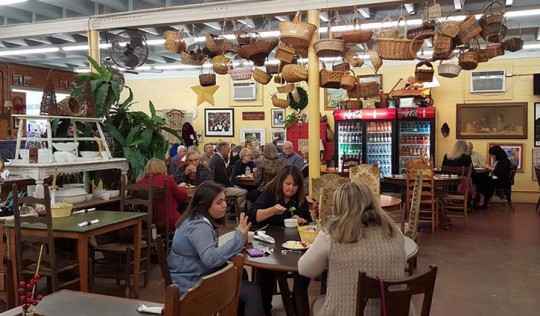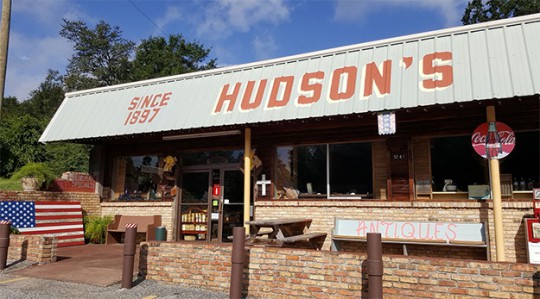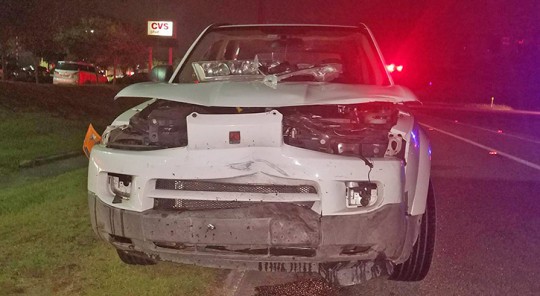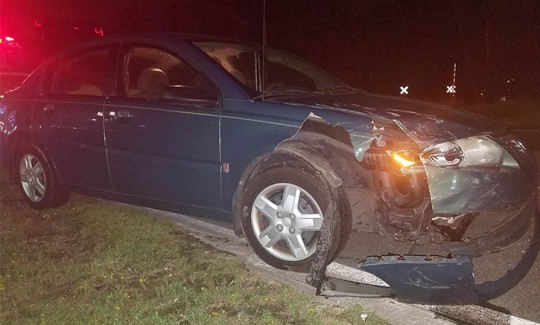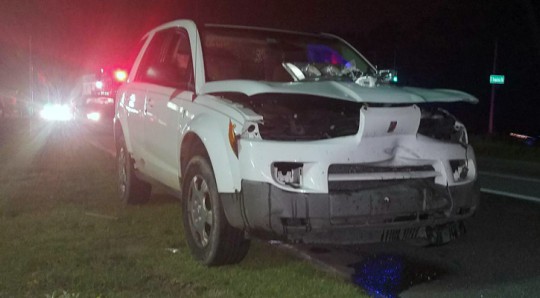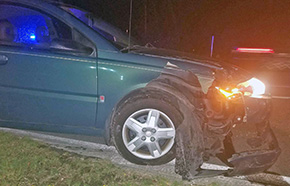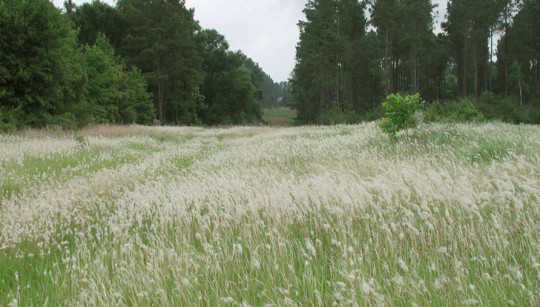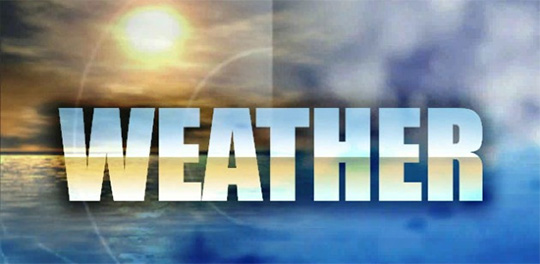Construction Projects Good News For Hudson’s, Other Century Businesses
September 4, 2017
Several Century businesses are celebrating the business growth they are experiencing due to two local construction projects.
When the lunch rush ended Friday at Mama Ruth’s Cafe in Century Friday, there wasn’t a drop of the daily special gumbo left, and there was not a piece of bread left in the restaurant.
 “It was a really busy day,” proprietor Mary Hudson Bourgeois said. But it’s not just the locals that have business booming at Hudson’s and several other Century businesses.
“It was a really busy day,” proprietor Mary Hudson Bourgeois said. But it’s not just the locals that have business booming at Hudson’s and several other Century businesses.
She credits the influx of business to the workers on two major projects — the construction of a 50-unit apartment complex behind the nearby Century Courthouse and a natural gas pipeline traversing Century before reaching Pensacola.
“They’ve been really good to support us and very, very kind to us,” Bourgeois said of the construction workers. “They’ve really supported us. And it’s nice to have people in town looking for good food.”
Mama Ruth’s Cafe is located inside Hudson’s Grocery on Highway 29 just south of West Highway 4. The store is not a traditional grocery store, but instead offers Amish Foods, antiques, collectables, gifts and a variety of merchandise and is open Thursday-Saturday from 11 a.m. until 3 p.m. and serves Sunday dinner at 11.
Pictured top: The traditional lunch crowd at Mama Ruth’s Cafe in Century has now greatly expanded due to a couple of local construction projects. Pictured below: The business is located on Highway 29 just south of West Highway 4. Pictured inset: Mary Hudson Bourgeois. Photos for NorthEscambia.com, click to enlarge.
Eyes On Hurricane Irma
September 4, 2017

Major Hurricane continues to move across the Atlantic. It’s still to early, according to forecasters, to say if the storm will make landfall in the U.S.
The latest details on Hurricane Irma are in the graphics above and below, click to enlarge.


Escambia County Labor Day Closures
September 4, 2017
Below is a listing of Escambia County offices and departments closed on Monday in observance of the Labor Day holiday. Normal operations resume on Tuesday unless otherwise noted.
- Escambia County Board of County Commissioners
- Escambia County Property Appraiser
- Escambia County Tax Collector
- Escambia County Area Transit administrative offices
- Escambia County Supervisor of Elections office
- Escambia County Clerk of the Circuit Court & Comptroller’s office
- Escambia County Animal Shelter
- West Florida Public Libraries (All locations)
Exceptions:
- ECAT will only operate the Pensacola Beach Trolley (regular schedule) on Monday, Sept. 4. There will be no ECAT bus or UWF Trolley service. All routes will resume regular service Tuesday, Sept. 5. For more information about ECAT schedules, click here or call 850-595-3228.
- Animal Control will be responding to emergency calls only.
- The Perdido Landfill will be open for normal business hours.
No Injuries In Highway 29 Crash
September 4, 2017
There were no injuries in a two vehicle crash Sunday night on Highway 29.
The crash happened near Kingsfield Road. All parties involved refused transport to the hospital.
The Ensley Station of Escambia Fire Rescue, Escambia County EMS, Escambia County Sheriff’s Office and the Florida Highway Patrol responded.
Pictured: There were no injuries in a two vehicle crash Sunday night on Highway 29 near Kingsfield Road. NorthEscambia.com photos, click to enlarge.
Florida Senate Pushes For Higher Education Changes
September 4, 2017
Universities would have to develop block tuition plans by next fall, and expansions in Bright Futures scholarships and need-based aid programs would become permanent under a Senate bill filed recently.
The legislation (SB 4), filed by Senate Higher Education Appropriations Chairman Bill Galvano, R-Bradenton, revives major parts of a higher-education bill (SB 374) passed during the 2017 legislative session but vetoed by Gov. Rick Scott.
A key difference is the new bill, which will be considered when the Legislature convenes in January, does not include measures related to state colleges. Those issues will be filed in a separate bill by Senate Education Chairwoman Dorothy Hukill, R-Port Orange.
Scott vetoed the 2017 bill citing concerns about the impact on the state college system.
Senate President Joe Negron, a Stuart Republican who has made elevating the state university system a top priority of his presidency, told the system’s Board of Governors that even with Scott’s veto of the policy bill, a major portion of the Senate’s higher-education initiative is already having a positive impact on the 12 state institutions.
Most of the Senate proposals were included in the new $82 billion state budget, including a record expansion of need-based aid and a major boost in Bright Futures scholarships, which are merit-based.
But as part of the annual budget, as opposed to being put into law, the changes are not permanent.
Negron told the Board of Governors, meeting at the University of Florida, that the idea behind the new Senate bill is “to make these tremendous gains permanent and to continue to build this vision” for an elite university system.
One provision in the bill would make permanent the expansion of the Bright Futures scholarships for the highest-performing students, known as “academic scholars,” to cover 100 percent of tuition and fees and to pay $300 per semester for books. Also, it would permanently allow academic scholars to use their Bright Futures awards to cover summer classes.
A new provision in the bill would expand the Bright Futures scholarships for “medallion” scholars to cover 75 percent of their tuition and fees. The scholarships now cover $77 of each credit hour, which average about $215 per hour across the university system.
The new bill also revives a proposed requirement that universities develop block tuition plans, where students pay a flat fee per semester rather than a credit-hour charge, with the new tuition plans taking effect in the fall of 2018.
“I think block tuition makes sense for a school like us,” said Michael Martin, the new president of Florida Gulf Coast University. “For one thing, it would create a reasonably good incentive for a student to carry as big a (class) load as they possibly can.”
Martin said it would help more students graduate quicker, which is one of the key performance standards for schools.
Kent Fuchs, president of the University Florida, said he likes the provisions in the bill that would bring permanency to the expansion of the need-based and merit-based financial aid programs.
“Any kind of aid that is a combination of need aware and based on merit really supports those students who are bright who can go to college anywhere but they can’t afford it, so we support that too,” he said.
Florida State University President John Thrasher, who helped create the original Bright Futures program when he was in the Legislature, said it’s “a great thing for students” to restore the scholarship program to cover full tuition, as it was originally designed.
“I think it should be fully funded,” Thrasher said. “I’m proud of Joe (Negron) for doing that.”
Scott said he has not seen the new Senate bill but supports the permanent expansion of the Bright Futures scholarships.
“I’ve been very supportive of making sure we fully fund Bright Futures,” Scott told reporters in Jacksonville. “I want to make sure that our students have Bright Futures that are covered both in the summer and cover all their costs.”
The new Senate bill also would authorize programs to help schools attract top-level professors and reward high-performing graduate schools. The current budget included $121 million for those programs, but the funding would be in doubt in subsequent years without the legislation.
The bill would also require schools seeking to become “pre-eminent” institutions, which qualifies them for more state funding, to meet a 60 percent four-year graduation rate. But the bill would allow schools, like the University of South Florida, that are expected to reach pre-eminent status in the next year to use the current standard of a 70 percent six-year graduation rate.
The bill would also impose a four-year graduation standard for all schools seeking performance funding. The formula now uses a six-year graduation measure.
Several financial-aid provisions did not survive Scott’s veto of the policy bill but would be renewed with passage of the new Senate bill.
Among them, it would double the state match for scholarships aimed at “first generation” in college students. Currently, it’s a one-to-one match for the funds.
A provision to extend to out-of-state students the Benacquisto scholarships, which pay full tuition for National Merit Scholars, would also be authorized in the new bill. Even without the out-of-state extension, Negron said funding in the budget increased the Benacquisto scholars to 873 this academic year, up from 665 last year.
The bill would also create a new scholarship program for students from farmworker families.
The Senate bill would prohibit university and state college foundations from using public funds to pay for travel. And by 2023, it would prohibit the “direct-support organizations” from using public funds to pay for personnel.
Workshop To Help Landowners Do Battle With Invasive Species
September 4, 2017
The Florida Forest Stewardship Program and the Six Rivers Cooperative Invasive Species Management Area are presenting a workshop September 28, 2017 from 9 a.m. to 3 p.m. at the University of Florida Extension office on Airport Road in Crestview.
The title of the workshop is Invasive Exotic Species and Control and the topics will include herbicide label, required personal protective equipment, applications techniques, herbicide resistance, modes of action, rotation, terrestrial and aquatic invasive exotic plants and control update, invasive species identification and look-alikes, established and new invasive exotic insects, and working with the Six Rivers CISMA.
Participants can learn about identifying and controlling cogon grass, Japanese climbing fern, privets and other non-native invasive species. Participants can earn pesticide applicator and forestry CEUs. Registration is $10 per person and participants may sign up on line at https://fsp-workshop092817.eventbrite.com or call (850) 689-5850.
Pictured top: Cogon grass. Photo for NorthEscambia.com, click to enlarge.
Sunny Skies For Labor Day
September 4, 2017
Here is your official North Escambia area forecast:
Labor Day: Mostly sunny, with a high near 89. Calm wind becoming south around 5 mph.
Monday Night: Partly cloudy, with a low around 69. South wind around 5 mph becoming calm.
Tuesday: A 20 percent chance of showers and thunderstorms. Partly sunny, with a high near 87. Calm wind becoming south around 5 mph in the afternoon.
Tuesday Night: A 40 percent chance of showers and thunderstorms. Mostly cloudy, with a low around 70. South wind around 5 mph becoming calm in the evening.
Wednesday: Showers and thunderstorms likely. Cloudy, with a high near 83. Calm wind becoming north around 5 mph in the afternoon. Chance of precipitation is 60%.
Wednesday Night: Mostly cloudy, with a low around 60. North wind around 5 mph.
Thursday: Sunny, with a high near 81. North wind around 5 mph.
Thursday Night: Mostly clear, with a low around 56. North wind around 5 mph.
Friday: Sunny, with a high near 82.
Friday Night: Clear, with a low around 59.
Saturday: Sunny, with a high near 84.
Saturday Night: Mostly clear, with a low around 62.
Sunday: Sunny, with a high near 85.
Wahoos Beat The Jumbo Shrimp
September 4, 2017
Pensacola starting pitcher Keury Mella turned in his fourth strong start in a row for the Blue Wahoos.
This time, the 24-year-old Dominican allowed one run in seven innings, while Pensacola third baseman Josh VanMeter singled in the winning run to help the Blue Wahoos overcome the Jacksonville Jumbo Shrimp, 2-1, Sunday at the Baseball Grounds of Jacksonville. The win tied the series, 2-2.
Mella gave up just four hits, no walks and struck out six. In the past four games, the right-hander has given up six runs, five earned in 25 innings for a 1.80 ERA, while striking out 23. He has turned his year around since the Mobile BayBears chased him from the game by scoring seven runs in 2.2 innings on Aug. 10
The victory improved his regular season record to 4-10 with a 4.30 ERA.
 Blue Wahoos closer Tanner Rainey picked up his fourth save in his last four appearances since Aug. 28. Rainey, whose fastball touches 100 mph, has not allowed a run or hit in his last six games, recording 13 strikeouts in 6.2 innings.
Blue Wahoos closer Tanner Rainey picked up his fourth save in his last four appearances since Aug. 28. Rainey, whose fastball touches 100 mph, has not allowed a run or hit in his last six games, recording 13 strikeouts in 6.2 innings.
Sunday, the big right-hander made it interesting, though. Rainey walked the first two batters he faced in the ninth inning. However, he got a strikeout and then Jacksonville right fielder John Norwood hit a line drive to second baseman Shed Long, who quickly threw to first to get Austin Dean out for a double play to end the game.
Pensacola rallied to beat Jacksonville with two out in the sixth inning by getting three singles in a row by right fielder Gabriel Guerrero, Long and third baseman Josh VanMeter. Guerrero’s single scored Mella, who had singled, to tie the Jumbo Shrimp, 1-1. Then VanMeter singled up the middle to drive in Long and put Pensacola up, 2-1.
Jacksonville’s only run of the game came on a solo home run by first baseman Justin Bour, who is on a rehab assignment from the Miami Marlins where he hit 21 homers this year.
Because Pensacola won the Southern Division in the first half, it will play Jacksonville, the second half champion, in the best of five game playoffs scheduled to start Sept. 6 at Blue Wahoos Stadium.
The Blue Wahoos won a Southern League record four halves in a row to tie the Tennessee Smokies, which also won four straight halves between 2009 and 2011.
Pensacola improved to 33-36 in the second half and 73-66 overall, while Jacksonville fell to 39-30 and 69-70.
Man Charged With Battery Of Girlfriend, Her Grandmother
September 3, 2017
An Escambia County man has been charged with battery on his girlfriend and her 69-year old grandmother.
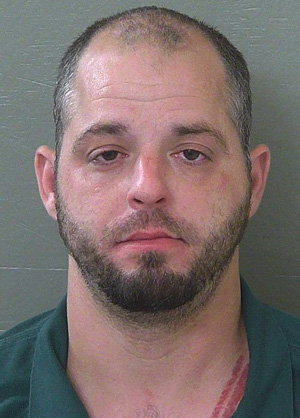 Deputies responded to the victim’s residence where she stated that her boyfriend, 31-year old Kristopher Durant Coates, had struck her several times in the face with a closed fist while the two were involved in a verbal argument. The victim told Escambia County Sheriff’s deputies that Coates also hit her grandmother in the face with a closed fist.
Deputies responded to the victim’s residence where she stated that her boyfriend, 31-year old Kristopher Durant Coates, had struck her several times in the face with a closed fist while the two were involved in a verbal argument. The victim told Escambia County Sheriff’s deputies that Coates also hit her grandmother in the face with a closed fist.
He fled on foot as the victim called deputies, according to an arrest report. He was taken into custody the following day.
Coates was charged with felony battery on a person 65-year of age or older and battery. He was released from the Escambia County Jail on bond.
Weekend Gardening: It’s Easy To Attract Hummingbirds
September 3, 2017
by UF/IFAS Extension Service
Few sights are more thrilling in the garden than rapidly moving hummingbirds darting among colorful flowers. Hummingbirds, also known as hummers, are always a wonder to see, and it’s easy to attract them to your garden.
In Florida, we see three different types of hummingbirds, but the most common is the ruby-throated. This feathered jewel is only about three inches long and weighs as little as a single penny.
For their size, hummingbirds have among the largest appetites in the bird world. They feed every 10 or 15 minutes from dawn until dusk. During this period, they eat more than half their weight in food and 8 times their weight in water.
If you’re fascinated by hummingbirds, you probably hang out a feeder or two in the summer to provide them with sugar water. Artificial feeders will attract hummingbirds.
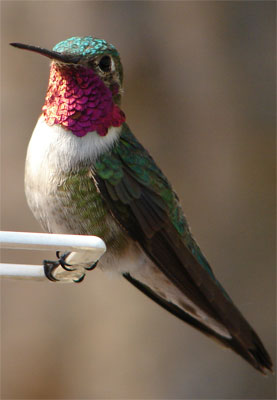 However, feeders should not be the sole source of food provided. The sugar solution may appeal to the hummingbirds’ sweet tooth, but it provides little nourishment. Nectar is much more vital to the hummingbird than just water and sugar. By planting certain flowers and shrubs, home gardeners can provide food and habitat for hummingbirds.
However, feeders should not be the sole source of food provided. The sugar solution may appeal to the hummingbirds’ sweet tooth, but it provides little nourishment. Nectar is much more vital to the hummingbird than just water and sugar. By planting certain flowers and shrubs, home gardeners can provide food and habitat for hummingbirds.
Typical hummingbird flowers are red, have a tubular shape and have no strong scent. But there are several notable exceptions to this general rule. Many plants with red flowers don’t contain very much nectar. Roses, petunias, geraniums and zinnias have brilliant colors but little nectar.
Plants that produce an abundance of flowers over an extended period of time and those that require little care are good choices. Native plants can “fill the bill” where nectar-seekers are concerned and should be used whenever possible.
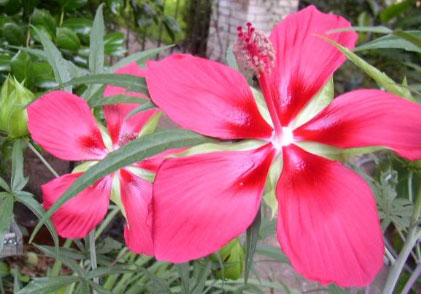 Perennials that are recommended as nectar sources include butterfly milkweed (Asclepias tuberosa), red basil (Calamintha coccinea), shrimp plant (Justicia brandegeana), cigar plant (Cuphea ignea), firespike (Odontonema stricta), red star hibiscus (Hibiscus coccineus), and obedient plant (Physostegia spp.).
Perennials that are recommended as nectar sources include butterfly milkweed (Asclepias tuberosa), red basil (Calamintha coccinea), shrimp plant (Justicia brandegeana), cigar plant (Cuphea ignea), firespike (Odontonema stricta), red star hibiscus (Hibiscus coccineus), and obedient plant (Physostegia spp.).
It’s also important to plant a mixture of nectar producing trees, vines and shrubs that have overlapping blooming seasons. This will insure that a continuous source of nectar will be available to hummingbirds throughout the growing season. Some of the species recommended include red buckeye, bottlebrush, firebush (Hamelia patens), wild azalea, trumpet vine, and coral honeysuckle.
Contrary to popular belief, hummingbirds are not strictly nectar feeders. Insects and other invertebrates are the primary source of protein for adult hummingbirds and their young. An adult female can consume up to 2,000 insects per day. Small invertebrates including mosquitoes, gnats, small bees, fruit flies, spiders, caterpillars, aphids, and insects eggs make up the hummingbirds diet. So keep your plants free of pesticides. Pesticides destroy the insect food base vital to hummingbirds and their offspring, and may also contaminate the nectar they drink.
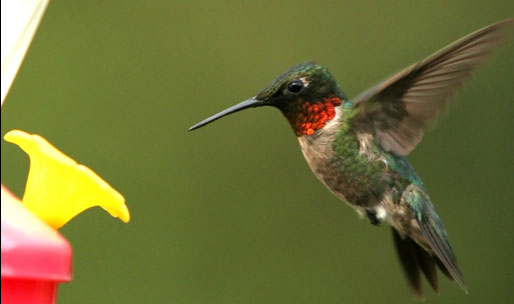 And if you do use artificial feeders, remember that the sugar solutions must be kept fresh. Florida’s hot weather can cause rapid bacterial growth in these feeders and birds that drink contaminated water could die. To avoid this, change the solution every 3 to 5 days. Clean the feeders with hot water and white vinegar. Do not use soap or chlorine bleach.
And if you do use artificial feeders, remember that the sugar solutions must be kept fresh. Florida’s hot weather can cause rapid bacterial growth in these feeders and birds that drink contaminated water could die. To avoid this, change the solution every 3 to 5 days. Clean the feeders with hot water and white vinegar. Do not use soap or chlorine bleach.


